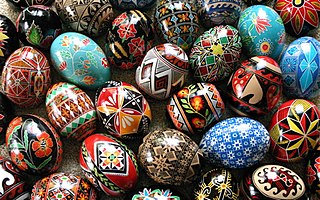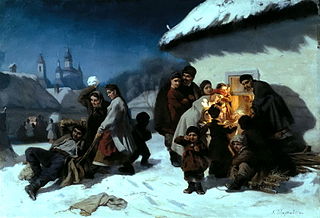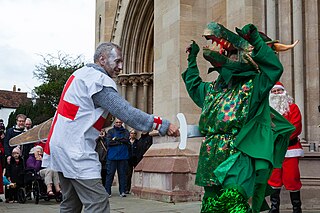 W
WThe Apple Feast of the Saviour or Apple Spas is an Eastern Slavic folk name for the Feast of the Transfiguration, which is observed on August 19.
 W
WBelarusian folk dance is a form of stage dance known for its originality. The history of Belarus and efforts to preserve Belarusian traditions have shaped the dances in use today, which have many ancient and archaic elements. These dances started to form in the 14th century, and originated in East Slavic rites. In the middle of the 19th century, traditional folk dancing began to merge with quadrilles and polkas from Western Europe.
 W
WDed Moroz is a legendary figure similar to Saint Nicholas, Father Christmas and Santa Claus who has his roots in Slavic mythology. The tradition of Ded Moroz is mostly spread in East Slavic countries and is an important part of Russian culture. Although at the beginning of the Soviet era communists banned Ded Moroz he soon became an important part of the Soviet culture. The literal translation is "Grandpa Frost".
 W
WDożynki is a Slavic harvest festival. In pre-Christian times the feast usually fell on the autumn equinox, in modern times it is usually celebrated on one of the Sundays following the end of the harvest season, which fall on different days in different regions of Europe.
 W
WThe tradition of egg decoration in Slavic cultures originated in pagan times, and was transformed by the process of religious syncretism into the Christian Easter egg. Nevertheless, these decorated eggs have retained much of their pagan symbolism.
 W
WGreen Week is an ancient Slavic fertility festival celebrated in early June and closely linked with the cult of the dead and the spring agricultural rites. In Russian villages, the seven weeks after Easter were a time of festivity, and Green Week took place during the seventh week leading up to Pentecost.
 W
WKoledari are Slavic traditional performers of a ceremony called koleduvane, a kind of Christmas caroling. It is associated with Koliada, a celebration incorporated later into Christmas.
 W
WKoliada or koleda is the traditional Slavic name for the period from Christmas to Epiphany or, more generally, to Slavic Christmas-related rituals, some dating to pre-Christian times. It represents "a winter festival celebrated at the end of December in honour of the sun".
 W
WKupala Night,, also called Ivanа-Kupala, is a traditional Slavic holiday that was originally celebrated on the shortest night of the year, which is on 21-22 or 23-24 of June and in Eastern Slavic countries according to traditional Julian calendar on the night between 6 to 7 July. Calendar-wise, it is opposite to the winter holiday Koliada. The celebration relates to the summer solstice when nights are the shortest and includes a number of Slavic rituals.
 W
WMalanka is a Russian, Ukrainian, Belarusian, folk holiday celebrated on 13 January, which is New Year's Eve in accordance with the Julian calendar.
 W
WMaslenitsa is an Eastern Slavic religious and folk holiday, which has retained a number of elements of Slavic mythology in its ritual, celebrated during the last week before Great Lent, that is, the eighth week before Eastern Orthodox Pascha.
 W
WMummers' plays are folk plays performed by troupes of amateur actors, traditionally all male, known as mummers or guisers. Historically, mummers' plays consisted of informal groups of costumed community members that visited from house to house on various holidays. Today the term refers especially to a play in which a number of characters are called on stage, two of whom engage in a combat, the loser being revived by a doctor character. This play is sometimes found associated with a sword dance though both also exist in Britain independently.
 W
WRadonitsa, also spelled Radunitsa, Radonica, or Radunica, in the Russian Orthodox Church is a commemoration of the departed observed on the second Tuesday of Pascha (Easter) or, in some places, on the second Monday of Pascha. In Ukrainian tradition it is called Provody (Проводи).
 W
WSlavic carnivals are known under different names in various Slavic countries: [Macedonian language: 'Прочка'(Prochka)], Bulgarian:Сирни заговезни, Прошка, Russian: Масленица, Мясопуст, Polish: Ostatki, Mięsopust, Zapusty, Czech: Masopust, Šibřinky, Ostatky, Slovak: Fašiangy, Slovene: Mesopȗst, Pust, Pustni teden, Fašnk, Serbian: Покладе, Poklade, Croatian: Pust, Poklade, Mesopust, Fašnik. They are traditional Slavic festivals related to the period of carnival.
 W
WThe Translation of the Relics of Saint Nicholas from Myra to Bari is a religious and folk holiday among the East Slavs and, to a lesser extent, the South Slavs and Eastern Romance peoples. It is celebrated on May 9 each year. For Old (Julian) Calendar churches, May 9 falls on May 22 of the New (Gregorian) Calendar. The feast commemorates the translation (movement) of the relics of Saint Nicholas from Myra to Bari, on the Italian Peninsula, to save them from the Turks, who were persecuting Christians and destroying churches and holy objects. To this day, the relics remain at the Basilica of Saint Nicholas.
 W
WZaduszki or Dzień Zaduszny is a Polish name of All Souls' Day, a Catholic holiday celebrated on 2 November, a day after All Saint's Day. The word Zaduszki originating from Dzień Zaduszny, can be roughly translated into English as "the day of prayers for the souls". On this day people visit cemeteries to light candles and pray for the souls of the dead, especially those believed to be in purgatory.